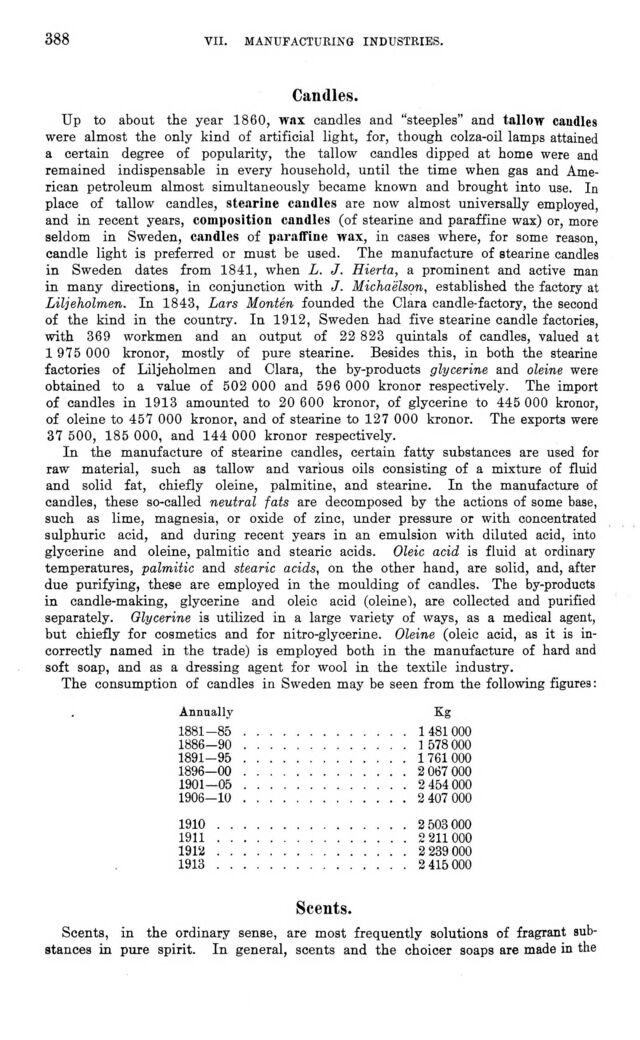
Full resolution (JPEG) - On this page / på denna sida - VII. Manufacturing Industries. Introd. by [G. Sundbärg] K. Åmark - 4. Oils, Tar, India-Rubber, and allied Commodities. By Alf. Larson

<< prev. page << föreg. sida << >> nästa sida >> next page >>
Below is the raw OCR text
from the above scanned image.
Do you see an error? Proofread the page now!
Här nedan syns maskintolkade texten från faksimilbilden ovan.
Ser du något fel? Korrekturläs sidan nu!
This page has never been proofread. / Denna sida har aldrig korrekturlästs.
388
vii. manufacturing industries.
Candles.
Up to about the year 1860, wax candles and "steeples" and tallow caudles
were almost the only kind of artificial light, for, though colza-oil lamps attained
a certain degree of popularity, the tallow candles dipped at home were and
remained indispensable in every household, until the time when gas and
American petroleum almost simultaneously became known and brought into use. In
place of tallow candles, stearine candles are now almost universally employed,
and in recent years, composition candles (of stearine and paraffine wax) or, more
seldom in Sweden, candles of paraffine wax, in cases where, for some reason,
candle light is preferred or must be used. The manufacture of stearine candles
in Sweden dates from 1841, when L. J. Hierta, a prominent and active man
in many directions, in conjunction with J. Michaëlson, established the factory at
Liljeholmen. In 1843, Lars Montén founded the Clara candle-factory, the second
of the kind in the country. In 1912, Sweden had five stearine candle factories,
with 369 workmen and an output of 22 823 quintals of candles, valued at
1 975 000 kronor, mostly of pure stearine. Besides this, in both the stearine
factories of Liljeholmen and Clara, the by-products glycerine and oleine were
obtained to a value of 502 000 and 596 000 kronor respectively. The import
of candles in 1913 amounted to 20 600 kronor, of glycerine to 445 000 kronor,
of oleine to 457 000 kronor, and of stearine to 127 000 kronor. The exports were
37 500, 185 000, and 144 000 kronor respectively.
In the manufacture of stearine candles, certain fatty substances are used for
raw material, such as tallow and various oils consisting of a mixture of fluid
and solid fat, chiefly oleine, palmitine, and stearine. In the manufacture of
candles, these so-called neutral fats are decomposed by the actions of some base,
such as lime, magnesia, or oxide of zinc, under pressure or with concentrated
sulphuric acid, and during recent years in an emulsion with diluted acid, into
glycerine and oleine, palmitic and stearic acids. Oleic acid is fluid at ordinary
temperatures, palmitic and stearic acids, on the other hand, are solid, and, after
due purifying, these are employed in the moulding of candles. The by-products
in candle-making, glycerine and oleic acid (oleinel, are collected and purified
separately. Glycerine is utilized in a large variety of ways, as a medical agent,
but chiefly for cosmetics and for nitro-glycerine. Oleine (oleic acid, as it is
incorrectly named in the trade) is employed both in the manufacture of hard and
soft soap, and as a dressing agent for wool in the textile industry.
The consumption of candles in Sweden may be seen from the following figures:
Annually Kg
1881-85 ..........................1481000
1886-90 .............1 578 000
1891-95 ..........................1761000
1896—00 ..........................2 067 000
1901—05 ..........................2 454 000
1906-10 ..........................2 407 000
1910 ..............................2 503 000
1911 ..............................2 211000
1912 ..............................2 239 000
1913 ..............................2 415 000
Scents.
Scents, in the ordinary sense, are most frequently solutions of fragrant
substances in pure spirit. In general, scents and the choicer soaps are made in the
<< prev. page << föreg. sida << >> nästa sida >> next page >>